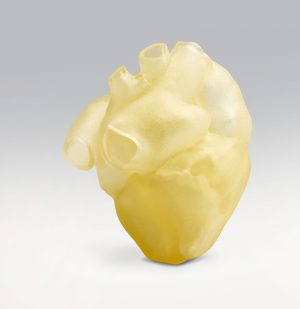In Finland, the VTT Technical Research Center has been developing a complex 3D generated wound care product that will be used for monitoring wound conditions while patients are in the hospital. More specifically, they're using cellulose nanofibrils that have properties that can improve the characteristics of bio-based 3D printing pastes.
Interestingly, the research center is pioneering this nanocellulose synthesis via textile decorative elements that will be used to mock up their production before using them for human wounds.
 This is a unique approach that’s proving to be quite effective.
This is a unique approach that’s proving to be quite effective.
3D Paste Printing
Of course, 3D printing has been an efficient manufacturing method used for many kinds of structures, from large scale fabrication of physical products, down to the nanotechnology level. But it's also been used with thermal plastics as well as a wide range of biomaterials for 3D paste printing.
3D paste printing, though useful and innovative, has been constrained, as pastes have posed some unique challenges in that their structure is not allowed to collapse during the printing process. Anything that's fabricated using this process must be strong, rigid, and flexible enough after drying to be useful.
But when it comes to 3D biomaterials, some commercial products already exist. That's the approach that's being used to further develop the biomaterials for wound care. Research is ongoing to improve on existing biomaterials and apply some sophisticated science to improve it and put it to work.
How the Nano-Bio Bandage Works
The VTT Research Center wound care prototype combines nanocellulose (a protein that's used in wound care) and printed electronics to measure wound healing in a single product. It employs measurement electrodes that are printed with silver ink (just like a printed circuit board) onto a film that's made of polyurethane-nanocellulose.
The electrodes provide connection points for other readers that may be intrinsic to this lamination, and a 3D-printed wound care gel that has nanocellulose as one of its active ingredients.
The reader can transmit very finite biomarkers such as temperature or other electrical data from the wound into a computer that's used by healthcare professionals remotely located to read and interpret the data that's being picked up.
In essence, a de facto nano-bio bandage has been created.
While nanocellulose has not yet been approved for medical use, it has great potential. Realistically, it could take several years before the application is seen in hospitals.
This is undoubtedly futuristic technology and certainly another example of the remarkable ability of 3D printing used to improve care for medical and health ailments such as wounds.
Decorative Elements to Biomedical Solutions
As previously mentioned, the VTT Research Center, sponsored by the Finnish government, is developing the technology by using modifications in textiles, mock ups, and indoor decorative elements for wound care applications under different projects.
This enables them to select appropriate combinations of materials and to print flexible and rigid structures according to the needs of their overall intent. It also allows product properties to be customized by other means that may be necessary to their intended design.
This unique and complex approach allows researchers to employ nanocellulose, which is quite valuable in increasing the opportunities to create new surface patterns. This development will require light and moisture tests in various applications, but enables printing materials to be used to 3D print customized molds.
By developing the technology in decorative elements, it can subsequently be transformed into bio-based applications that would help monitor wounds.
The future will tell the success of these efforts; it's probably going to be several years before it actually begins to have a significant impact, however, it does portend the future of 3D printing. The successful use of nanotechnology and nanocellulose has helped solved very difficult and complex biomedical problems.
In the past, such an approach was likely never considered to be solved by any technology, let alone 3D printing. It only highlights the importance and value that 3D printing is bringing to many different industries in a myriad of ways.

Want to learn more about 3D printing in the medical industry? Check out the new Stratasys Digital Anatomy Printer which can print realistic human anatomical models that mimic bone and tissue.



